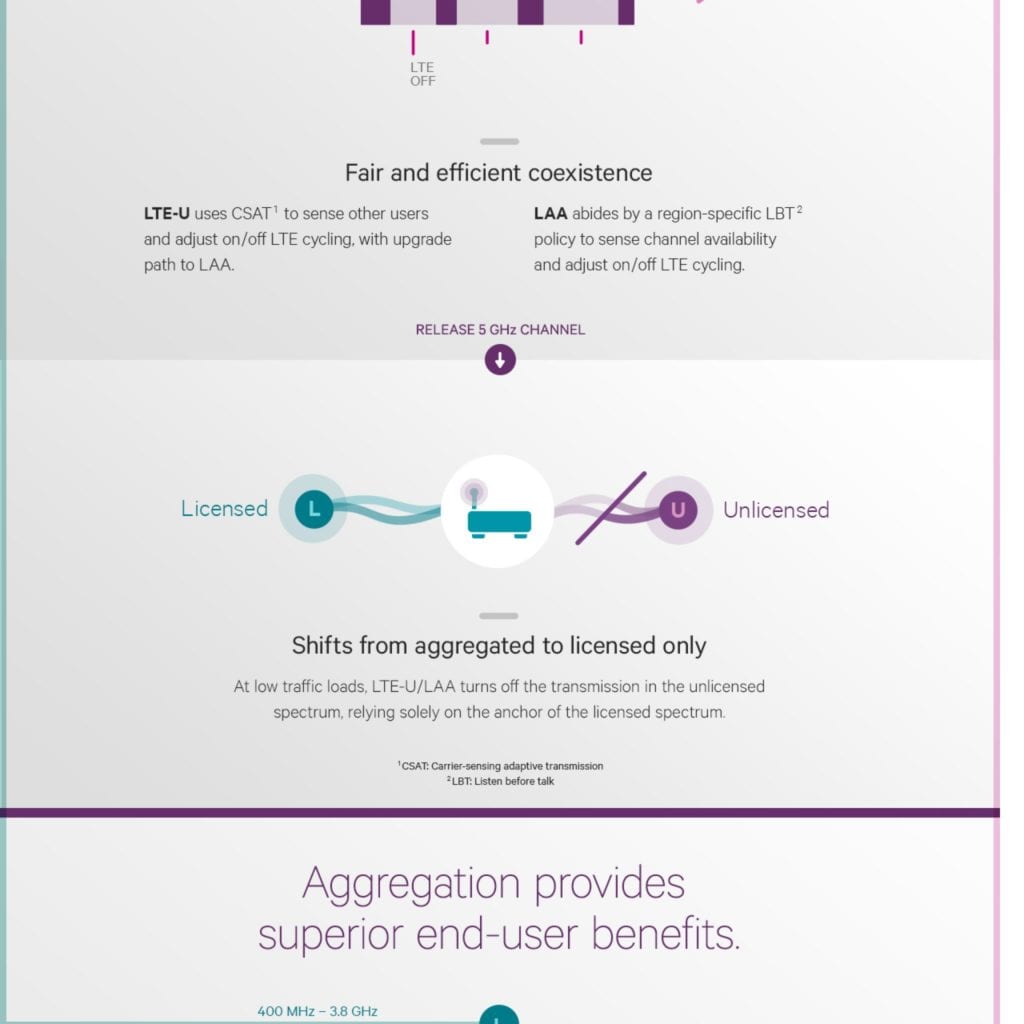A recent Wi-Fi Alliance workshop on the relationship of Wi-Fi and LTE over unlicensed spectrum continued the industry dialog on how the two technologies can co-exist with one another, and meanwhile, a new round of skeptical testing by CableLabs and an update of the LTE-U specification by the LTE-U Forum have emerged.
According to the Wi-Fi Alliance, meeting attendees included Amazon, Broadcom, Dell, Ericsson, Gibson Brands, Google, Intel, NTT, Qualcomm, Toyota and Verizon, among others. The Wi-Fi Alliance recently released a set of initial coexistence guidelines (downloadable from this page — presentations from the workshop are also available) for testing the impact of LTE-over-unlicensed on Wi-Fi
As a reminder, there are two flavors of LTE-over-unlicensed that are under debate — the most controversial of which is the proprietary form being driven by a group of vendors and operators in the LTE-U Forum, which relies on duty-cycling in order to not interfere with Wi-Fi; and the standardized License-Assisted Access or LAA, which relies on a listen-before-talk approach. The final spec for LAA is still working its way through the standards process. Qualcomm has a new infographic that breaks down the differences (see below) and also mentions its MuLTEfire technology designed for standalone LTE-over-unlicensed deployments.
Proponents of LTE-U have argued that it is as friendly to Wi-Fi as Wi-Fi is to itself, and the Wi-Fi Alliance said that it considered its coexistence testing based on “the impact of the [LTE-over-unlicensed] system on Wi-Fi users in the channel is no worse than the impact that would result from an additional Wi-Fi network introduced into the channel supporting the same traffic load as the system. A technology capable of being used in unlicensed channels is fair to Wi-Fi if its deployed implementations will always operate fairly as described above.”
However, in its latest update to the LTE-U specification, the LTE-U Forum acknowledged (pdf) that in situations with LTE-U small cells utilized by multiple providers, “there are scenarios where all available channels are occupied by Wi-Fi devices, which forces LTE-U [small cells] to operate on the same channel as Wi-Fi. Wi-Fi devices do not back off to LTE-U unless its interference level is above the energy detection threshold (-62dBm over 20MHz). Without proper coexistence mechanisms, LTE-U transmissions could cause considerable interference on Wi-Fi network relative to Wi-Fi.”
“Such an unplanned and unmanaged deployment of LTE-U [small cells] (femtocells, picocells) may result in excessive RF interference to the existing co-channel Wi-Fi and 4 LTE-U Forum other operator LTE-U nodes in the vicinity,” the LTE-U Forum spec said. “It is therefore critical for LTE-U SCs to choose the best operating channel while minimizing the interference caused to nearby Wi-Fi and LTE-U networks.”
In a statement on the Wi-Fi Alliance meeting, Qualcomm said that the company and its LTE-U partners “have had an ongoing dialogue with the Wi-Fi community to ensure that LTE-U does not cause any adverse impact on Wi-Fi. We have a strong vested interest in ensuring that LTE-U coexists successfully with Wi-Fi in view of our own Wi-Fi business.
Qualcomm said that it “[looks] forward to continuing collaboration with the Wi-Fi Alliance and its members to answer questions, ease concerns, address issues, and reach agreement.”
CableLabs, meanwhile, has continued its testing of LTE-U with a sharp focus on co-existence, and presented its most recent results at the Wi-Fi Alliance meeting. In a recent blog entry, Jennifer Andreoli-Fang, principal architect in CableLabs’ network technologies group, Rob Alderfer, VP technology policy; and Nadia Yoza-Mitsuishi, wireless architect intern, documented the test results and concluded that they “[highlight] the need for the open and collaborative R&D that we have long been urging, so that we can find solutions that actually work for everyone. … Hopefully LTE-U proponents will move toward actual collaboration.”
CableLabs has tested LTE-U and Wi-Fi coexistence in its offices and most recently, in a residential test house that it uses to examine Wi-Fi functionality in an actual home environment. Using off-the-shelf Wi-Fi access points and an LTE signal generator programmed for duty-cycling, CableLabs found that “Wi-Fi performance suffered disproportionately in the presence of LTE-U” and that Wi-Fi throughput was degraded by 70% when LTE-U was on 50% of the time, and that longer on-times for LTE-U had an even greater impact. Comparatively, when the two Wi-Fi APs were sharing the spectrum, CableLabs said that the throughput was roughly 50:50.

“Why does LTE-U do disproportionate damage to Wi-Fi? The primary reason is that it interrupts Wi-Fi mid-stream, instead of waiting its turn,” the CableLabs authors wrote. “This causes errors in Wi-Fi transmissions, ratcheting down its performance. We ran tests across a range of duty cycles to explore this effect. In our test case of two networks sharing with each other, to maintain Wi-Fi at 50% throughput, LTE-U could be on for no more than 35% of the time.”
As far as the new spec, CableLabs said that “we’re still looking at it along with the rest of the Wi-Fi community, since it is again a product of their closed process, but we don’t think it changes much for our purposes here. And judging by the discussion at this week’s Wi-Fi Alliance workshop, much work remains to get to reliable coexistence.”


